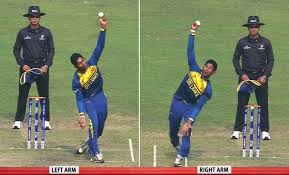 |
| Kamindu Mendis in action(s). |
I like the idea of evolution. The Charles Xavier type more than Charles Darwin's. The first X-Men movie starts with a narration by Patrick Stewart that goes something like this: “Mutation: it is the key to our evolution. But every few hundred millennia, evolution leaps forward.”
Cricket finds itself in one such phase, caught in the middle of a jump in evolution. It has changed more in the last 10 years than in the last 100. The tipping point, without a doubt, was the birth of the T20 format. It precipitated bigger bats, longer hits, slower
bouncers, frequent yorkers, umpires with helmets.
And switch-hits.
Kevin Pietersen’s switch-hit inspired mixed reaction and fierce debate on the legalities, yet everybody agreed on one thing: it was spectacular. Ambidextrous cricketers suddenly became the new buzzword, and ambidexterity is the new cool.
It is no surprise, therefore, that now we have bowlers who can use both arms. Tuesday’s semi-final against India featured Sri Lanka’s batting all-rounder Kamindu Mendis who can bowl both off-spin and left-arm spin.
He prefers to take the ball away from a batter. Mendis bowls right-arm off-spin to left-handers and left-arm tweakers to right-handers, negating the advantage of having a left-right batting combination at the crease. The youngster didn’t get a load of wickets but has certainly cornered a lot of attention. Could he be the product of a generation who grew up watching guys like Pietersen play switch hits? After all, Mendis was only 10 in 2008 when Pietersen first unleashed the shot.
One gentleman who most likely won’t be surprised by Mendis’s ability is John Buchanan, coach of Australia when they were at their most dominant. I remember reading his predictions about ambidextrous cricketers in his aptly named book, ‘If better were possible’. Back in 2003, Buchanan had said: “We’ll have players, hopefully by the next World Cup (2007), who can use both sides of their bodies. I don’t think we will be at the stage when players bowl with both hands in four years’ time — but maybe in eight.”
Buchanan’s timelines may be a bit off but he was certainly on the right track. The number of batters proficient at switch-hitting is on the rise. And ambidextrous bowlers are cropping up too. Take Vidharbha’s Akshay Karnewar, for instance.
With truly ambidextrous players appearing at the U19 and List A level, it is a matter of time before we see these skills on the international stage. While a number of cricketers bat with one hand and bowl with the other, they cannot be called truly ambidextrous.
In one of my earliest blogs, I had argued that it was only common sense for a player who bowls right handed to bat left-handed. This is because a batter’s top hand is his/her dominant hand. Thus it is only natural for people who are naturally right-handed to be taught to bat left-handed, as this ensures that their strong hand becomes their top hand. However, a player can only be called truly ambidextrous if he/she can perform the same skill equally adroitly with both hands.
There can be no doubt that ambidextrous cricketers add variety and excitement to the game. But at what cost? Commentator Harsha Bhogle, back in 2012, labelled switch-hit as ‘unfair’. He said, “(It) strikes at the sanctity of our sport, which must seek to maintain a balance between bat and ball.”
A bowler is required to declare to the umpire (and thus the batter) which side of the wicket he will bowl from, and using which arm. However, when a batter performs a switch, he gives the bowler no such intimation and thus gains an unfair advantage. That the ICC ratified switch-hit despite this anomaly is further proof of the ‘batter’s game mindset’ that dogs cricket.
Baseball, which has encountered both switch-hitters and switch-pitchers, recently introduced the ‘Pat Venditte rule', after an ambidextrous pitcher of the same name came up against a switch-hitting batter. The pitcher must first indicate to the plate umpire with which hand he intends to throw, and then the batter decides from which box he intends to hit. Neither can change their chosen hand during that ball. Safe to say that baseball has more respect for pitchers than cricket has for bowlers?
The trump card of ambidextrous cricketers, batters or bowlers, is the options they create. It is the surprise element. People often speak of a bowler getting inside a batter’s head, and anticipating where he will play. This becomes exponentially more difficult if the batter switches sides and opens up more scoring areas.
Such is the advantage that switch-hitters possess. But the laws give no such advantage to the bowlers. Why not give them the same choice? Imagine if a bowler had the option to bowl over or round the wicket, and with left or right hand, without informing the batter or the umpire? Just as a switch-hitter challenges the bowler to think on his feet, such a situation would keep the better guessing till the last minute. As a bowler, I know I would have loved to have these options while I was playing.
I am glad the switch-hit is legal, make no mistake. Cricket would be poorer without its athleticism and innovation. But just as the game appreciates, authorises and embraces batters who can bath on both sides, so too must it pay attention to the other side of the story. A pugilist who only strengthens his dominant hand will surely regret it in a fight.
This article first appeared on Firstpost.com
No comments:
Post a Comment